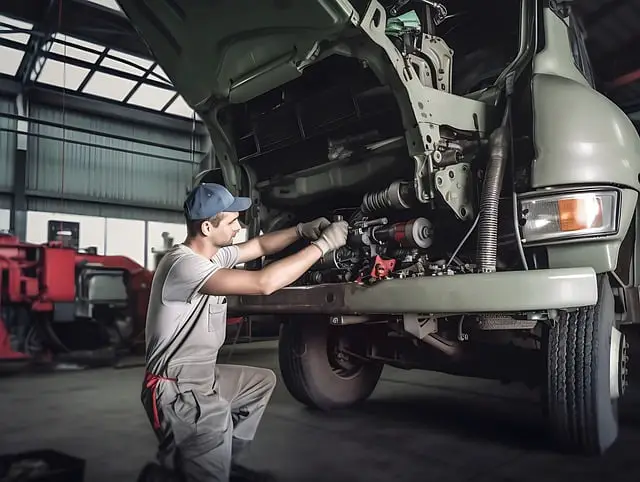Fleet management involves overseeing a group of vehicles used for commercial purposes. Part of the job is maintaining truck parts. Ensuring proper upkeep of truck parts lets fleets work well. It keeps drivers and cargo safe.
All components that make the vehicle keep moving in the right way and avoid breakdowns need regular care.
This article explores essential truck parts maintenance aspects that you have to know as a fleet manager.
Common Truck Parts That Require Maintenance
Tires
Tires undergo significant wear and tear from constant use. So regular inspections are important. Monitoring tread depth and inflation levels ensures optimal traction and road safety. Neglecting tire maintenance leads to reduced fuel efficiency, increased blowout risk, and compromised vehicle handling.
Brakes
Brakes are critical for keeping vehicles and occupants secure, needing routine checks to work right. Regular inspections of brake pads, discs, and hydraulic systems spot wear signs and prevent brake failures. Poor brake maintenance can result in longer stopping distances, increased accident risks, and costly repairs.
Engine Components
Engine parts play a big role in vehicle performance and reliability, requiring periodic maintenance. Change your oil, and regularly check the power steering fluid, coolant, brake fluid, and transmission fluid levels. Routine cleaning also prevents breakdowns and ensures optimal engine performance. Failure to do that can lead to reduced fuel efficiency and costly repairs.
Factors Affecting Truck Part Maintenance
Quality of Replacement Parts
The type of replacement parts used during truck maintenance significantly impacts part reliability greatly. According to the team at Shoreline Truck Parts, getting high-quality replacement parts from a respectable manufacturer will ensure your parts last longer and reduce the frequency of replacements and downtime.
Low-quality parts can be cheap but may lead to costly downtime, safety risks, and additional expenses. Keep in mind that high-quality aftermarket parts ensure compatibility and reliability, leading to smoother operations and fewer breakdowns.
Regular Inspection Schedules
Fleet managers must adhere to regular inspection schedules. This lets them detect potential issues early on with truck parts like tires, brakes, and engine components. By conducting scheduled inspections, the company can save on expensive repairs and component replacements and prevent truck accidents.
Driving Conditions
Driving conditions like road terrain and area weather have a big impact on truck parts, such as wear and tear. Vehicles operating in harsh environments or rough terrain experience greater stress.
This leads to faster deterioration of components like tires, suspension systems, and brakes. Extreme weather conditions, such as excessive heat or cold, also affect the performance and longevity of various parts.
Benefits of Proactive Truck Part Maintenance
Improved Vehicle Performance and Efficiency
Regular truck maintenance boosts vehicle performance and fuel efficiency. Checking and servicing parts like engines, transmissions, and tires ensure components run best. This results in smooth operation, better power output, and improved fuel economy.
Increased Safety for Drivers and Cargo
Actively maintaining truck parts promotes driver and cargo safety. Proactivelyidentifying and addressing potential issues with critical components like brakes, tires, and suspension systems prevent unexpected failures that could jeopardize road safety.
Routine maintenance ensures all safety-critical systems operate as intended, decreasing accident, injury, and cargo damage risks. This proactive approach instills driver confidence and maintains a safe
Cost Savings on Major Repairs
Regular truck part maintenance saves major repair costs. Catching issues early prevents little problems from escalating into expensive breakdowns needing extensive repairs or replacements.
Routine activities like inspections, lubrication, and adjustments keep parts in top shape, reducing the likelihood of unexpected failures and related repair expenses. This proactive approach cuts repair costs and minimizes downtime, boosting fleet productivity and profitability.
Compliance with Regulations
Keeping truck parts are well-maintained to ensure compliance with safety regulations and industry standards. Regulatory bodies impose strict rules on commercial vehicle maintenance and operation to protect public safety and the environment.
Proactive maintenance practices like regular inspections, servicing, and record-keeping demonstrate a commitment to upholding these regulations.
Strategies for Effective Truck Part Maintenance
Implementing a Preventive Maintenance Program
A preventive maintenance schedule keeps truck parts working well. Routinely inspecting, oiling, and adjusting stops small issues from becoming costly repairs or breakdowns. This method helps parts last longer, ensures efficient performance, and reduces unexpected downtime – making the fleet very reliable.
Tracking Maintenance Schedules and Records
Thorough maintenance records assist in tracking progress effectively. Details about inspections, fixes, and service intervals identify patterns, show trends, and allow the planning of future tasks smoothly. Accurate data aids decisions about budgets, resources, and scheduling. Proper upkeep can also be crucial when dealing with legal issues.
Training Drivers on Maintenance Best Practices
Giving drivers lessons on upkeep guidelines is very important. It makes sure any issues get noticed and fixed quickly. Drivers are crucial for spotting problems early by reporting strange or unusual behavior as they are the ones handling the vehicle.
Teaching drivers basic inspections, pre-trip checks, and recognizing worn or damaged parts lets fleet managers get help monitoring the critical parameters and help intervene promptly before they can escalate, requiring major replacements or causing an accident.
Utilizing Technology for Maintenance Alerts and Tracking
Using technology to issue alerts and keep tabs on things simplifies maintenance and improves efficiency. Advanced fleet systems can generate alerts automatically for scheduled upkeep based on vehicle usage, miles driven, or time passed.
These alertsremind fleet managers to take action promptly, ensuring maintenance tasks aren’t ignored or delayed. Technology also lets managers monitor vehicle health data remotely in real-time, allowing quick intervention if something seems off or there are issued.
Challenges in Truck Part Maintenance
Budget Constraints
Constrained budgets can make comprehensive upkeep difficult. Fleet overseers might have to prioritize which maintenance activities to focus on based on urgency and cost effectiveness when money is tight. This involves making hard choices about components to service or fix, potentially impacting overall vehicle dependability and performance.
Inventive ways to maximize maintenance spending efficiency become crucial for managing limited funds’ effect on fleet operations.
Finding Reliable Maintenance Providers

Seeking trusted vehicle upkeep professionals present difficulties, mainly in distant locales with confined choices. Fleet supervisors must thoroughly research and carefully examine possible service providers.
Their know-how, accreditations, and client appraisals can enlighten decision-making. Nurturing strong bonds with reliablemaintenance providers and fostering timely and quality services, thus contributing to the overall safety and integrity of the fleet.
Taking care of truck parts in the right way is critical. It keeps fleets running smoothly and keeps drivers and cargo safe. Smart managers utilize proactive maintenance tactics and tackle the daunting maintenance issues head-on.














Leave a Reply